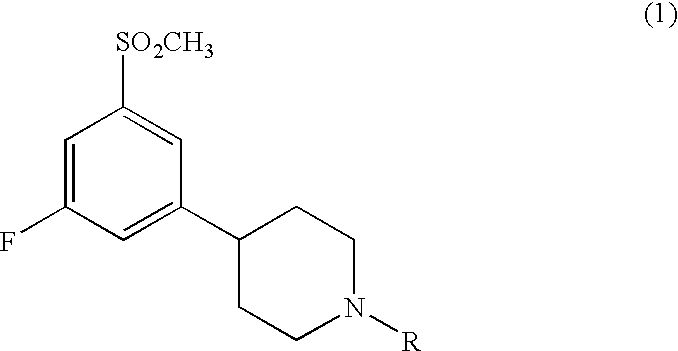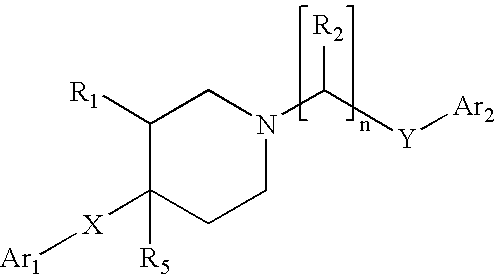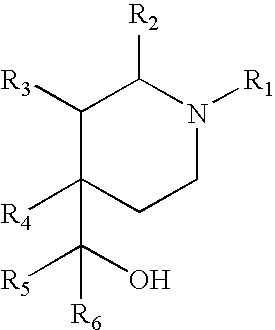3,5-Disubstituted Phenyl-Piperidines as Modulators of Dopamine Neurotransmission
a technology of phenylpiperidines and disubstituted phenylpiperidines, which is applied in the direction of heterocyclic compound active ingredients, drug compositions, biocides, etc., can solve the problems of low potency, no guidance in neither wo01/46145 (formula i) nor wo01, and no evidence of antipsychotic activity of ligands in schizophrenic patients, etc., to achieve low potency and low risk of qt interval
- Summary
- Abstract
- Description
- Claims
- Application Information
AI Technical Summary
Benefits of technology
Problems solved by technology
Method used
Image
Examples
example 1
4-[3-fluoro-5-(methylsulfonyl)phenyl]-1-propylpiperidine
[0095]To a solution of 4-[3-fluoro-5-(methylsulfonyl)phenyl]piperidine (0.5 g, 1.94 mmol) in acetonitrile (5 ml) was added potassium carbonate (0.53 g, 3.83 mmol) and 1-iodopropane (0.189 ml, 1.94 mmol) and the mixture was heated with microwave irradiation for 20 min at 150° C. The mixture was cooled to ambient temperature and water (50 ml) was added. The aqueous residue was extracted with ethylacetate (3×50 ml) and the combined organic phases was dried, concentrated, and purified by flash column chromatography (ethylacetate / methanol, 1:1) to give the title compound (0.27 g, 46%). The amine was converted to the hydrochloric acid salt and recrystallized from ethanol / diethyl ether: M.p. 187-189° C. MS m / z (relative intensity, 70 eV) 299 (M+, 3), 271 (15), 270 (bp), 147 (5) 133 (5).
example 2
1-ethyl-4-[3-fluoro-5-(methylsulfonyl)phenyl]piperidine
[0096]Preparation according to Example 1: 4-[3-fluoro-5-(methylsulfonyl)phenyl]piperidine (0.4 g, 1.55 mmol), acetonitrile (5 ml), potassium carbonate (0.42 g, 3.0 mmol), 1-iodoethane (0.147 ml, 1.55 mmol). Yield: 0.28 g (63%). The amine was converted to the hydrochloric acid salt and recrystallized from ethanol / diethyl ether: M.p. 176-178° C. MS m / z (relative intensity, 70 eV) 285 (M+, 15), 284 (16), 271 (16), 270 (bp), 84 (15).
Synthesis of Intermediates Used in the Above Examples are Described in the Preparations Below.
preparation 1
1-bromo-3-fluoro-5-(methylthio)benzene
[0097]To a solution of 1-bromo-3,5-difluorobenzene (5.0 g, 25.9 mmol) in dimethylformamide (40 ml) was added sodiumthiomethylate (1.81 g, 25.9 mmol), and the mixture was heated to 150° C. for 10 min. The reaction mixture was brought to ambient temperature, quenched with saturated aqueous ammonium chloride (100 ml) and extracted with ethylacetate (3×100 ml). The combined organic phases was dried and concentrated in vacuo to receive the pure title compound (3.84 g). MS m / z (rel. intensity, 70 eV) 222 (M+, 100), 220 (M+, 100), 189 (49), 187 (50), 126 (75).
PUM
 Login to View More
Login to View More Abstract
Description
Claims
Application Information
 Login to View More
Login to View More - R&D
- Intellectual Property
- Life Sciences
- Materials
- Tech Scout
- Unparalleled Data Quality
- Higher Quality Content
- 60% Fewer Hallucinations
Browse by: Latest US Patents, China's latest patents, Technical Efficacy Thesaurus, Application Domain, Technology Topic, Popular Technical Reports.
© 2025 PatSnap. All rights reserved.Legal|Privacy policy|Modern Slavery Act Transparency Statement|Sitemap|About US| Contact US: help@patsnap.com



